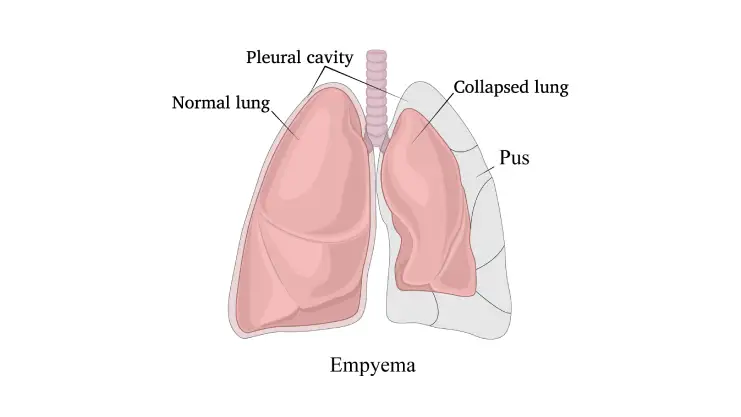Empyema, a condition characterized by the accumulation of pus in the pleural cavity, is a serious medical issue that requires prompt and effective treatment. Often arising as a complication of pneumonia, empyema can lead to severe health problems if not addressed quickly. Understanding the effective treatment options for empyema is crucial for patients and healthcare providers alike. This blog explores the various treatments available, highlighting the importance of timely intervention and comprehensive care.
Understanding Empyema
Empyema is a collection of pus within the pleural space, the area between the lungs and the chest wall. It typically results from an infection that spreads to this space, often following bacterial pneumonia, but can also be caused by lung abscesses, chest surgery, or trauma.
Symptoms of Empyema
Common symptoms include:
- Fever and chills
- Chest pain
- Shortness of breath
- Cough
- Fatigue
- Weight loss
Early diagnosis and treatment are essential to prevent complications such as lung damage and sepsis.
Effective Treatment Options
Antibiotic Therapy
Antibiotic therapy is the cornerstone of Empyema Effective Treatment Options, especially in its early stages. Broad-spectrum antibiotics are typically administered initially, followed by more targeted antibiotics once the specific bacteria causing the infection are identified. The duration of antibiotic therapy may vary, but it often continues for several weeks to ensure complete eradication of the infection.
Drainage Procedures
When empyema progresses beyond the simple accumulation of pus (simple empyema) to a more complex stage where pus becomes loculated or thickened, drainage becomes necessary. There are several methods for draining the infected fluid:
Thoracentesis
Thoracentesis involves inserting a needle through the chest wall into the pleural space to remove fluid. This procedure is often used for diagnostic purposes or to drain small amounts of fluid. It can provide relief from symptoms and help determine the next steps in treatment.
Chest Tube Insertion (Thoracostomy)
For more advanced cases, a chest tube may be inserted to continuously drain pus from the pleural space. This procedure involves placing a tube through the chest wall and connecting it to a suction device. Chest tube insertion is typically performed under local anesthesia and guided by imaging techniques to ensure proper placement.
Video-Assisted Thoracoscopic Surgery (VATS)
VATS is a minimally invasive surgical procedure used to remove infected fluid and debris from the pleural space. It involves making small incisions and using a thoracoscope (a small camera) to visualize the pleural cavity. VATS is effective for treating empyema that does not respond to chest tube drainage and can also help break down loculations.
Decortication
In cases where empyema leads to the formation of thick fibrous tissue (fibrothorax), decortication may be necessary. Decortication is a surgical procedure that removes this fibrous tissue, allowing the lungs to re-expand and function properly. It is usually considered when other treatments have failed or if the lung is significantly compressed.
Intrapleural Fibrinolytic Therapy
Intrapleural fibrinolytic therapy involves administering medications directly into the pleural space to break down fibrinous adhesions and loculations, making it easier to drain the pus. This therapy can be used in conjunction with chest tube drainage to enhance the effectiveness of treatment.
Supportive Care
Supportive care plays a vital role in the overall management of empyema. This includes:
- Pain Management: Adequate pain relief to improve breathing and comfort.
- Nutritional Support: Ensuring the patient receives proper nutrition to support healing.
- Respiratory Therapy: Techniques and exercises to improve lung function and facilitate recovery.
Conclusion
Empyema is a serious condition that requires prompt and effective treatment to prevent complications and ensure a full recovery. A combination of antibiotic therapy, drainage procedures, surgical interventions, and supportive care forms the cornerstone of effective empyema management. Early diagnosis and a tailored treatment approach are crucial for the best outcomes.
If you or a loved one is experiencing symptoms of empyema, it is essential to seek medical attention immediately. With the right treatment and comprehensive care, recovery is possible, allowing patients to return to their daily lives and activities.






